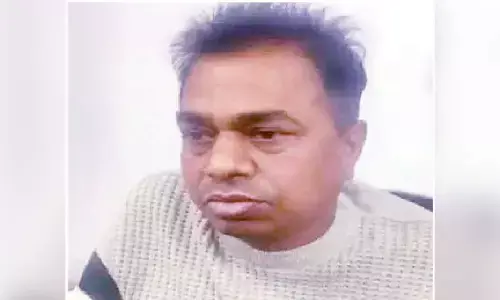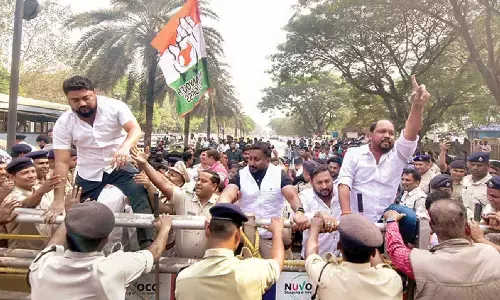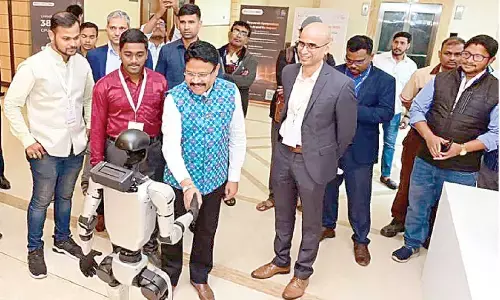Nrityopachara Dance School’s First Ballet ‘Sri Ramuni Charitamu’ in 2024

Nrityopachara Bharatanatyam dance school, founded by Praveena Vadapalli in 2015, is set to present its first ballet on 6th October 2024 at Bharatiya Vidya Bhavan, Basheerbagh. Titled “Sri Ramuni Charitamu,” the performance will feature traditional compositions and a vibrant ensemble of young artists
Gangavalli: Nrityopachara Bharatanatyam dance school, established in 2015 by Praveena Vadapalli, is preparing to present its first ballet on 6th October 2024 at Bharatiya Vidya Bhavan, Basheerbagh. Having completed nine successful years, the school will showcase a production titled Sri Ramuni Charitamu, a classical Bharatanatyam ballet. With a team of 20 young artists, full of energy and enthusiasm, Praveena has chosen predominantly traditional compositions, with a few new ones crafted specifically for this ballet by Sri Dandibotla Vaikunta Narayana Murthy, and set to music by Pavani Mutnuri.
The ballet will feature two significant episodes: “Sita Apaharana” and “Surpanakha,” which are expected to be standout performances. The jatis in the “Sita Apaharana” sequence are choreographed by Renuka Prasad, while the jatis for the “Yuddham” episode are composed by Praveena’s Nattuvangam Guru, Vidwan Sri D V Prasanna Kumar.
The musical ensemble supporting the performance includes renowned musicians from the twin cities: Sri Kanakam Chandra Rao on vocals, Chandrakanth on mridangam, Sai Kolanka on violin, Uma Venkateswarulu on flute, and Sridhar Acharya on rhythms. Leading roles will be portrayed by CTSS scholarship holders Nandini Sripathi (Rama), Shreya Kalluri (Hanuman), and Ananya Krishna Kumar (Surpanakha). Other performers include Annika Athmakuri as Sita, Shubhi Gupta as Lakshmana, and Amulya Kriti Boddapati as Ravana.
Sri Ramuni Charitamu will begin with a traditional Pushpanjali, followed by Adi Shankaracharya’s Eka Sloki Ramayanam, setting a reverent tone for the performance. A composition by Sri Dandibotla Narayana Murthy, “Sita Ramula Siri Charitammu,” will represent the Putrakamesti Yagam. The ballet will include a Varnam in Todi, “Sri Rama Chandra Nanu Brova Manchi Samayamu Ra,” covering episodes such as Viswamitra Yagam and Tataki’s defeat, leading into Sita Swayamvaram.
Praveena hasskillfully used a Mallari to introduce Sita, hidden behind a veil, as she plays ball with her friends. The scene transitions into a lively Tamil composition, “Swayamvaran Vela Vandadu,” full of humor (hasya rasa). The kings’ unsuccessful attempts to lift the bow are followed by Ravana’s failure as well. The “Sita Kalyana Vaibhava” is anticipated to fill the auditorium with a celebratory atmosphere.
To depict Rama’s Pattabhishekam, two talented dancers from Nishrinkhala, Sravani and Shravya, will perform a folk song from the movie Luva Kusa titled “Ramanna Ramudu.” This joyful performance will mark the announcement of the divine coronation.
The Kaikeyi episode, part of the Todi Varnam, shows her asking for the boons to banish Rama and Lakshmana. The Ramadasa Keertana “Ramayya Tandri” will be used in a folk style for Guha welcoming Rama and crossing the Ganges. A pivotal scene, the Surpanakha episode, was written exclusively for this ballet. Ananya will portray Surpanakha, with Praveena drawing inspiration from Tulsidas Ramayana to highlight Surpanakha’s interactions with Rama and Lakshmana, culminating in her transformation and attack on Sita, which leads to her nose and ears being cut off.
The “Sita Apaharana” sequence is a highly anticipated moment, packed with energetic jatis. These include Sita and Rama in the forest, the appearance of the golden deer, the chase, and Ravana’s entrance, concluding with the battle between Jatayu and Ravana.
The Sundarakanda section will be depicted through a Purandara Dasa Keertana, “Hanumanta Deva Namo,” and will culminate in Lankadahanam. For the building of the Rama Setu, an Annamacharya Keertana, “Bhali Bhali Rama,” will be choreographed with agile movements, emphasizing the monkey army’s efforts. “Sara Sara Samari” will accompany the war sequences, featuring alternating jatis to heighten the intensity.
The ballet will conclude with Rama’s Pattabhishekam, as he walks into the auditorium through the audience to the famous composition, “Kalyana Rama.” An anonymous composition, tuned by Kanakam Chandar Rao, “Sri Rama Pattabhishekam,” will depict the coronation events, and the performance will end with a Mangalam, “Ramachandrayya Mangalam.”













